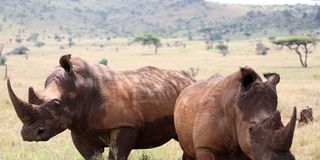Translocation of black rhinos to Loisaba Conservancy set to boost population

Black rhinos in the Borana-Lewa ecosystem
Rhino translocations have become a crucial modality in the preservation and protection of endangered wildlife species.
The government has translocated 21 black rhinos from the Nairobi National Park to Loisaba Wildlife Conservancy.
The translocation, which was presided over by Tourism and Wildlife Cabinet Secretary Alfred Mutua, underscores the significance of rhinos as a key species in biodiversity balance and drivers of the tourism industry.
“The translocation is significant in the conservation journey and recovery efforts of the black rhinos,” said Dr Mutua.
The government has stepped up efforts to protect rhinos that were on the brink of extinction three decades ago.
The seventh translocation of the 21 black rhinos will reduce overcrowding at Nairobi National Park.
Six translocations of black rhino have been implemented as part of the Recovery and Action Plan for Black Rhino in Kenya for the year 2022-2026.
The bid to decongest rhino populations in their sanctuaries across Kenya is critical as increased rhino populations easily lead to spikes in their mortality due to substandard ecological capacity for the rhino sanctuaries.
The translocation process began in 2018 when Loisiba Conservancy made an application to be considered a rhino sanctuary.
Dr Mutua said the translocation process was implemented in strict compliance with the International Union for Conservation of Nature (IUCN) Translocation guidelines and Immobilization and Translocation Protocol for Black Rhinos.
The Kenya Wildlife Services Director General Erastus Kanga observed that the translocation process was part of security measures against poaching.
Kenya currently hosts the third-largest rhino population in Africa, after South Africa and Namibia.
“With some of Kenya’s existing 16 sanctuaries nearing maximum capacity, there is an urgent need to create new ones offering ideal conditions, the right habitat, effective security, and strong support from neighbouring communities," said Dr Kanga.
KWS research shows Kenya needs 2,000 black rhinos for the species to survive in the face of threats including climate change, disease, poaching and loss of habitat.
Black rhinos are solitary animals and without enough room to disperse, they cannot breed well.
The successful translocation was supported San Diego Zoo Wildlife Alliance, The Nature Conservancy, The Elewana Collection and Space for Giants.
According to the Loisaba Conservancy Chief Executive Officer Tom Silvester, Kenya’s black rhino numbers have quadrupled from 240 in 1984 to 966 today.
Loisiba Conservancy's last species of the rhino was killed 50 years ago by poachers.
The recovery has been attributed to Kenya’s fight against poachers.
“It’s incredibly exciting to be part of the reintroduction of rhinos to a landscape where they’ve been absent for 50 years. It means so much to us,” said Mr Silvester.
Loisaba Conservancy has set aside half of its 58,000 acres for the rhinos.
The securing of the new sanctuary has been achieved by establishing a tight security operation and low-profile fencing to allow free movement of all other wildlife species.
The Nature Conservancy Kenya Program Director Munira Bashir asserted that securing a rhinoceros’ habitat at Loisaba Conservancy would consequently compel the government to support the rhinos’ conservation project, which will translate to conservation benefits in the country.
Ms Bashir noted that in the 1970s, Kenya had more than 20,000 black rhinos, but 20 years later they were reduced to 400 due to rampant poaching.
According to Ms Bashir, Kenya’s rhino population continues to thrive as some of the country’s existing 16 rhino sanctuaries are nearing maximum capacity and there is an urgent need to create new ones.
The San Diego Zoo Wildlife Alliance Chief Conservation and Wildlife health officer Nadine Lamberski lauded the translocation process of the rhinos to Loisaba Conservancy.
Head of Conservation and Wildlife at Lewa Wildlife Conservancy Domonic Maringa said the translocation will secure the future of these animals.
Head of Research and Species Conservation at Ol Pejeta Conservancy Samuel Mutisya said the translocation would ensure the expansion of the black rhino habitat in Kenya.





